No results were found for the filter!

Johann Sebastian Bach
Air from the Orchestral Suite No. 3, BWV 1068 Contrabass and piano
Simplified piano accompaniments by Philip Lehmann from practice for practice. ‘Dumb it down’ is a series of simplified piano accompaniments to standard works for various instruments, which also offer piano players without a degree the opportunity to accompany their pupils, children, friends etc. The edition includes QR codes to playalongs in various tempi with the original piano setting. Level of difficulty 2* : must be looked at before the lesson, practised before the concert * For the most part, it is sufficient to play the left hand (in class) The edition is also available as a pdf file. Click on the drop-down menu under ‘ISSUE (please select)’.
Mehr €9.00 *
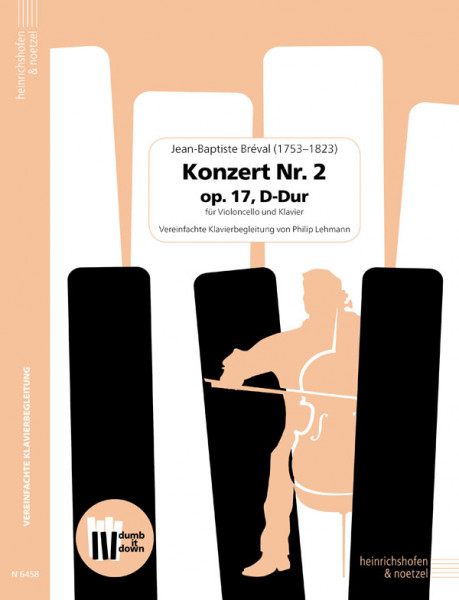
Jean-Baptiste Bréval
Concerto No. 2 op. 17, D major Violoncello and piano
Simplified piano accompaniments by Philip Lehmann from practice for practice. ‘Dumb it down’ is a series of simplified piano accompaniments to standard works for various instruments, which also offer piano players without a degree the opportunity to accompany their pupils, children, friends etc. The edition includes QR codes to playalongs in various tempi with the original piano setting. Level of difficulty 3 : Fingerings may need to be entered and practised. The edition is also available as a pdf file. Click on the drop-down menu under ‘ISSUE (please select)’.
Mehr €11.50 *

Camille Saint-Saëns
Le Cygne (the swan) Violoncello and piano
From practice for practice: ‘dumb it down’ is a series of simplified piano accompaniments by Philip Lehmann to standard works for various instruments, which also offer pianists without a degree the opportunity to accompany their pupils, children, friends, etc. ‘Le Cygne’ comes from the cycle “Le Carnaval des animaux”, in which 14 small works for various instrumentations were summarised. The original instrumentation of the piece was violoncello and two pianos. The edition contains QR codes to playalongs in various tempi with the original piano setting. Level of difficulty 1 : Beginner, can be sight-read The edition is also available as a pdf file. Click on the drop-down menu under ‘ISSUE (please select)’.
Mehr €9.00 *
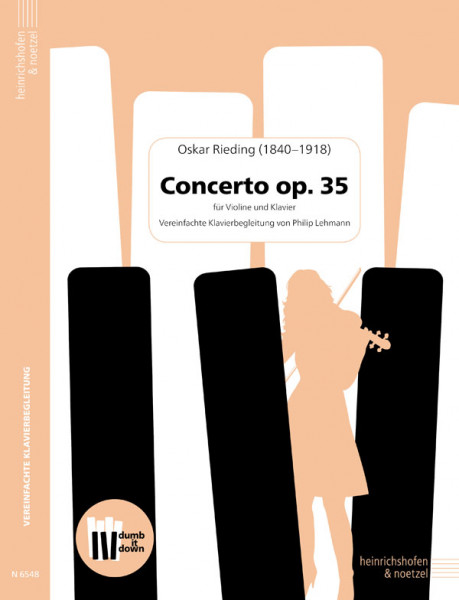
Oskar Rieding
Concerto op. 35 Violin and piano
From practice for practice: ‘dumb it down’ is a series of simplified piano accompaniments to standard works for various instruments, which also offer piano players without a degree the opportunity to accompany their pupils, children, friends, etc. Often only the first movement of this standard work of violin literature is used in lessons. We have therefore decided to indicate the level of difficulty as ‘3’. Despite the simplifications, the last movement is rather more difficult. On the other hand, the accompaniment with the left hand only is attractive from a musical point of view. Some of the repeated quavers/sixteenth notes have been notated with abbreviations. These repetitions can, but do not have to be played. The edition contains QR codes to playalongs in various tempi with the original piano setting. Level of difficulty 3* : Fingerings may need to be entered and practised * For the most part, it is sufficient to play the left hand (in lessons) The edition is also available as a pdf file. Click on the drop-down menu under ‘ISSUE (please select)’.
Mehr €11.00 *
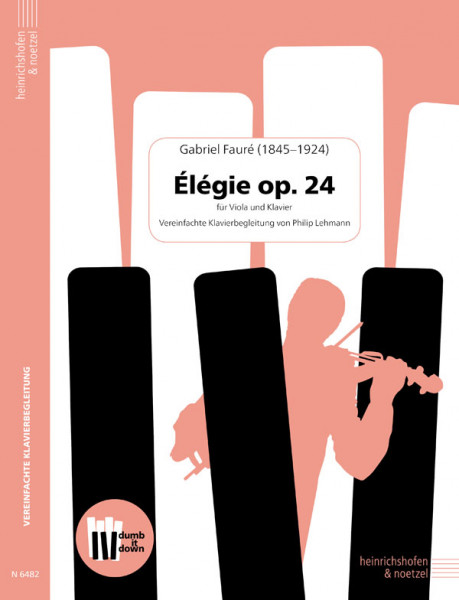
Gabriel Fauré
Élégie op. 24 Viola and piano
From practice for practice: ‘dumb it down’ is a series of simplified piano accompaniments by Philip Lehmann to standard works for various instruments, which also offer piano players without a degree the opportunity to accompany their pupils, children, friends etc.. The edition includes QR codes to playalongs in various tempi with the original piano setting. Level of difficulty 4 : Compared to the original, the piano setting has been greatly simplified, but can still be practised by amateurs The edition is also available as a pdf file. Click on the drop-down menu under ‘ISSUE (please select)’.
Mehr €9.00 *
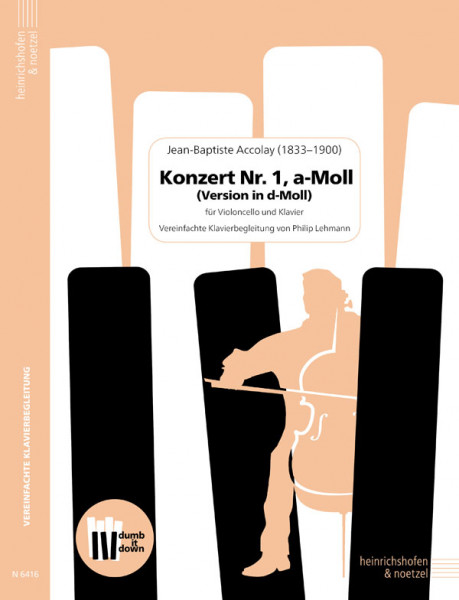
Jean-Baptiste Accolay
Concerto No. 1 in A minor (version in D minor) Violoncello and piano
Simplified piano accompaniments by Philip Lehmann from practice for practice. ‘Dumb it down’ is a series of simplified piano accompaniments to standard works for various instruments, which also offer piano players without a degree the opportunity to accompany their pupils, children, friends etc. This concerto is one of the standard works that are inevitably learnt on the way into the world of violin literature. In order to make this popular performance work accessible to cello students, it has been transposed to D minor. The edition contains QR codes for play-alongs in various tempi with the original piano setting. Level of difficulty 3 : Fingerings may need to be entered and practised The edition is also available as a pdf file. Click on the drop-down menu under ‘Issue (please select)’.
Mehr €11.50 *
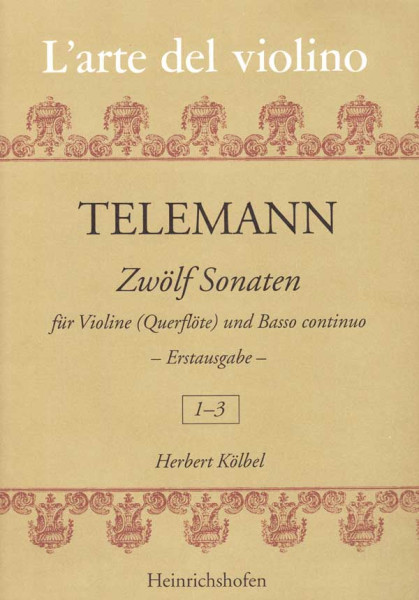
Georg Philipp Telemann
Twelve sonatas | sonatas 1 - 3 | volume 1 Violin ( flute) and basso continuo
First edition This edition is based on a manuscript from the Staatsbibliothek Berlin, Preußischer Kulturbesitz, Musikabteilung. It comes from the estate of Telemann, who gave it to his grandson Georg Michael Telemann (1748-1831). G. Poelchau acquired the manuscript in 1834 with a pack of music stored in a church tower in Riga. From Poelchau's estate († 1836) the sonata work came to the Royal Library in Berlin. The sonatas are dedicated to the brothers Rudolf, Hieronymus and Johannes Wilhelm Burmester of a Hamburg patrician family dated 1 March 1734, with the note that they follow the ‘12 methodical sonatas’, which were also dedicated to the first two brothers. The close connection between the two large sonata works can be found in their valuable musical content, in the sequence of movements (slow, fast, slow, fast), and in the succession of keys (C-a-D-h-E-F-d-G-e-A-f sharp-g). The bass lines are often involved in the theme. Occasionally we are reminded of J.S. Bach's inventions. In the title, the violin is named as the solo instrument before the flute, as several sonatas are unmistakably written “violinistically” without this hindering their playability for flute. The present edition adheres strictly to the manuscript. Suggestions for dynamics are indicated as such by brackets, as are those for articulation (by dotted lines), which may differ for violinists from those intended for flute. Experienced players should use the original figured bass for their own interpretation. The 12 sonatas made available to the public here for the first time are among the best compositions of this kind by Telemann, who dedicated them to 'connoisseurs and lovers' with the wish '...faire une bonne partie de Vos amusements'. The sonatas will fulfill this purpose today just as they did at that time.
Mehr €27.50 *
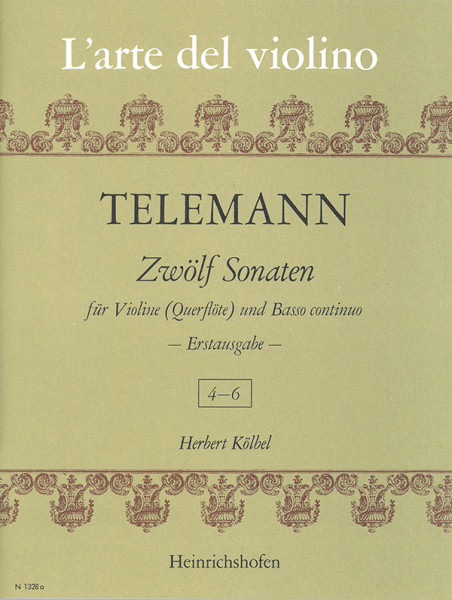
Georg Philipp Telemann
Twelve sonatas | sonatas 4 - 6 | volume 2 Violin (flute) and basso continuo
First edition This edition is based on a manuscript from the Staatsbibliothek Berlin, Preußischer Kulturbesitz, Musikabteilung. It comes from the estate of Telemann, who gave it to his grandson Georg Michael Telemann (1748-1831). G. Poelchau acquired the manuscript in 1834 with a pack of music stored in a church tower in Riga. From Poelchau's estate († 1836) the sonata work came to the Royal Library in Berlin. The sonatas are dedicated to the brothers of a Hamburg patrician family (Rudolf, Hieronymus and Johannes Wilhelm Burmester) dated 1 March 1734, with the note that they follow the ‘12 methodical sonatas’, which were also dedicated to the first two brothers. The close connection between the two large sonata works can be found in their valuable musical content, in the sequence of movements (slow, fast, slow, fast), and in the succession of keys (C-a-D-h-E-F-d-G-e-A-f sharp-g). The bass lines are often involved in the theme. Occasionally we are reminded of J.S. Bach's inventions. In the title, the violin is named as the solo instrument before the flute, as several sonatas are unmistakably written “violinistically” without this hindering their playability for flute. The present edition adheres strictly to the manuscript. Suggestions for dynamics are indicated as such by brackets, as are those for articulation (by dotted lines), which may differ for violinists from those intended for flute. Experienced players should use the original figured bass for their own interpretation. The 12 sonatas made available to the public here for the first time are among the best compositions of this kind by Telemann, who dedicated them to ' connoisseurs and lovers' with the wish '. ..faire une bonne partie de Vos amusements' . The sonatas will fulfill this purpose today just as they did at that time. Content: IV. Largo Allegro Andante Vivace V. Largo Allegro Grave Vivace VI. Andante Presto Cantabile Vivace
Mehr €27.50 *
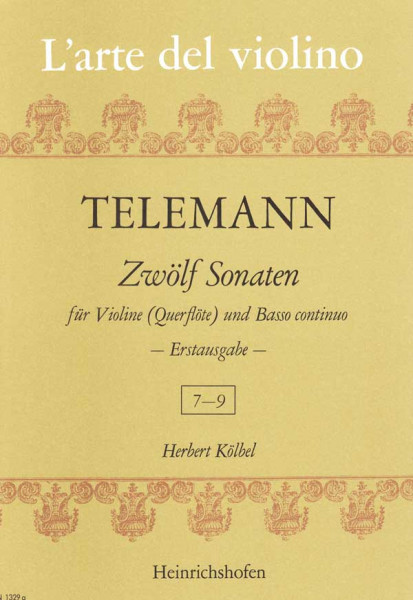
Georg Philipp Telemann
Twelve sonatas | sonatas 7 - 9 | volume 3 Violin (flute) and Basso continuo
First edition This edition is based on a manuscript from the Staatsbibliothek Berlin, Preußischer Kulturbesitz, Musikabteilung. It comes from the estate of Telemann, who gave it to his grandson Georg Michael Telemann (1748-1831). G. Poelchau acquired the manuscript in 1834 with a pack of music stored in a church tower in Riga. From Poelchau's estate († 1836) the sonata work came to the Royal Library in Berlin. The sonatas are dedicated to the brothers Rudolf, Hieronymus and Johannes Wilhelm Burmester of a Hamburg patrician family dated 1 March 1734, with the note that they follow the ‘12 methodical sonatas’, which were also dedicated to the first two brothers. The close connection between the two large sonata works can be found in their valuable musical content, in the sequence of movements (slow, fast, slow, fast), and in the succession of keys (C-a-D-h-E-F-d-G-e-A-f sharp-g). The bass lines are often involved in the theme. Occasionally we are reminded of J.S. Bach's inventions. In the title, the violin is named as the solo instrument before the flute, as several sonatas are unmistakably written “violinistically” without this hindering their playability for flute. The present edition adheres strictly to the manuscript. Suggestions for dynamics are indicated as such by brackets, as are those for articulation (by dotted lines), which may differ for violinists from those intended for flute. Experienced players should use the original figured bass for their own interpretation. The 12 sonatas made available to the public here for the first time are among the best compositions of this kind by Telemann, who dedicated them to 'connoisseurs and lovers' with the wish '...faire une bonne partie de Vos amusements'. The sonatas will fulfill this purpose today just as they did at that time.
Mehr €27.50 *
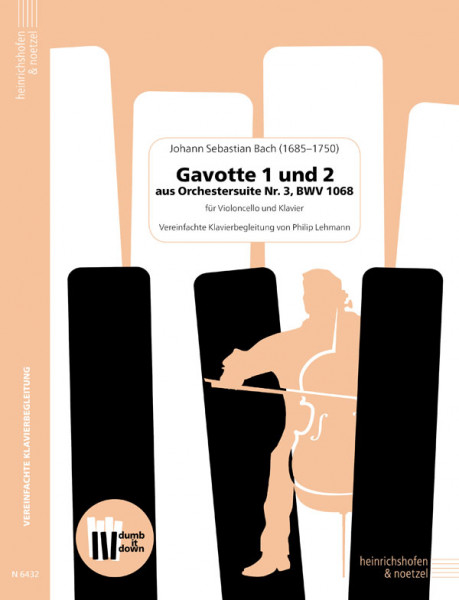
Johann Sebastian Bach
Gavotte 1 + 2 from the Orchestral Suite No. 3, BWV 1068 Violoncello and piano
Simplified piano accompaniments by Philip Lehmann from practice for practice. ‘Dumb it down’ is a series of simplified piano accompaniments to standard works for various instruments, which also offer piano players without a degree the opportunity to accompany their pupils, children, friends etc. The edition includes QR codes to playalongs in various tempi with the original piano setting. Level of difficulty 3* : Finder movements may need to be memorised and practised * For the most part, it is sufficient to play the left hand (during lessons) The edition is also available as a pdf file. Click on the drop-down menu under ‘Issue (please select)’.
Mehr €9.00 *
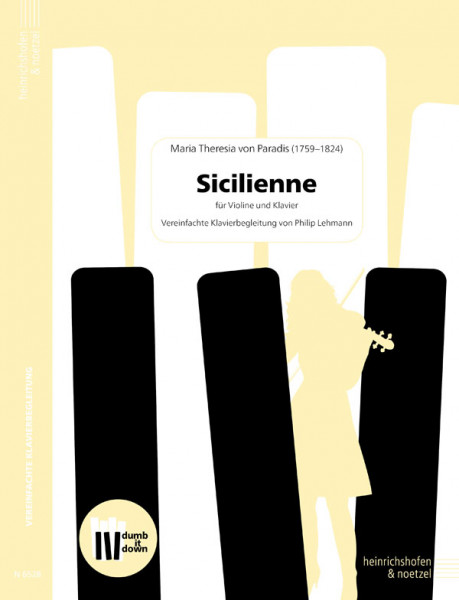
Maria Theresia von...
Sicilienne Violin and piano
According to the encyclopaedia ‘Musik in Geschichte und Gegenwart’, the ‘Sicilienne’ became famous through the arrangement for violin and piano by Samuel Dushkin. The key he used is E flat major. The edition contains QR codes to playalongs in various tempi with the original piano setting. Level of difficulty 2 : must be looked at before the lesson, practised before the concert The edition is also available as a pdf file. Click on the drop-down menu under ‘ISSUE (please select)’.
Mehr €8.00 *

Oskar Rieding
Concerto op. 35 Viola and piano
From practice for practice: ‘dumb it down’ is a series of simplified piano accompaniments to standard works for various instruments, which also offer piano players without a degree the opportunity to accompany their pupils, children, friends, etc. Often only the first movement of this standard work of violin literature is used in lessons. We have therefore decided to indicate the level of difficulty as ‘3’. Despite the simplifications, the last movement is rather more difficult. On the other hand, the accompaniment with the left hand only is attractive from a musical point of view. Some of the repeated quavers/sixteenth notes have been notated with abbreviations. These repetitions can, but do not have to be played. The edition contains QR codes to playalongs in various tempi with the original piano setting. Level of difficulty 3* : Fingerings may need to be entered and practised * For the most part, it is sufficient to play the left hand (in lessons). The edition is also available as a pdf file. Click on the drop-down menu under ‘ISSUE (please select)’.
Mehr €11.00 *
Viewed
